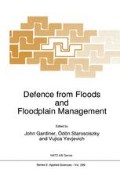Abstract
Social and psychological dimensions associated with flood hazards are becoming increasingly recognised as important aspects of flood risk management. To understand how people evaluate and respond to natural hazards, such as floods, is relevant for the adoption of adequate and viable solutions, both in structural and non-structural terms. For this reason, engineering approaches and solutions must be associated and complemented with tools provided by the cognitive sciences, namely psychology and sociology.
Access this chapter
Tax calculation will be finalised at checkout
Purchases are for personal use only
Preview
Unable to display preview. Download preview PDF.
References
Caude, G. (1988) L’inondation des villes, une Phénomène Maîtrisable? Les annales de la Recherche Urbaine, Dunod 40, Paris
Correia, F.N.; Saraiva, M.G.; Soczka, L.; Soeiro C. (1990) Public Perception and Public Participation in Water Projects. European Conference of Water Management, Commission of the European Communities and French Ministry of Environment, La Villete, Paris.
Correia, F.N.; Saraiva, M.G.; Soczka, L. (1992) Coping with Floods in Setúbal: A Few steps Towards an Integrated Approach. in Rossi et al. (eds), Coping with Floods, Kluwer Academic Publisher, Dordrecht pp. 733–751.
Correia, F.N., Saraiva, M.G., Rocha, J., Fordham, M., Bernardo, F., Ramos, I., Marques, Z. and Soczka, L. (1994) The Planning of Flood Alleviation Measures: Interface with the Public. In Penning-Rowsell, E. and M. Fordham (eds) (1994) Floods Across Europe: Flood Hazard Assessment, Modelling and Management. Middlesex University Press, London.
Emery, J. (1986) Disaster, Distress, Disease. Flood Hazard Research Centre. Middlesex University, Enfield.
Fordham, M.H. (1992) Choice and Constrains in Flood Hazard Mitigation: the Environmental Attitude of Floodplain Residents and Engineers, Flood Hazard Research Centre, Middlesex University, Enfield.
Green, C.H., Tunstall, S.M. and Fordham, M. (1990) Perceptions of the Risks of Flooding, Flood Hazard Research Centre, Middlesex University, Enfield.
Green, C.H.; Tunstell, S.M.; Fordham, M. (1990) The Risks from Flooding: which Risks and whose Perceptions, Flood Hazard Research Centre, Middlesex University, Enfield.
Kates et al. (1978) Risk Assessment of Environmental Hazard. John Wiley Publishers, Chichester.
Kates, (1962) Hazard and Choice Perception in Floodplain Management,. University of Chicago, Department of Geography, Research Paper no 78.
Keeney, R.L. and Winterfeld, D.V. (1986) Improving Risk Communication. Risk Analysis, no 6.
Laska, S.B. (1990) Homeowner Adaption to Flooding: an Application of the General Hazards Coping Theory, Environment and Behaviour, Vol. 23 no 3, Sage Publications.
Lima, L. (1989) Contributes para o Estudo da representação do Risco, Laboratório National de Engenharia Civil, Lisboa.
Lima, M.L. (1993) Percepção de Riscos Ambientais: Representações e Identidades Sociais. Comunicação no I Colóquio de “Ambiente: 4, Educação e Política Ambientais, ISPA, Lisboa.
Lave, T.R. and Lave, L.B. (1991) Public Perception of the Risks of Floods: Implications for Communication, Risk Analysis, Vol II no 2
LNEC (1986) Estudo Hidrológico e Hidráulico das Cheias e Inundações na Cidade de Setúbal (Hydrological and Hydraulic Study of Floods in the Town of Setúbal) Relatórios 245 e 246/86 — NHHF, Lisboa.
Moore, H. E. (1964) And the Winds Blew. University of Texas, Austin, Texas, U.S.A.
Penning-Rowsell, E. C. (1976) The effect of flood damage on land use planning Geographica Polonica, 34.
Penning-Rowsell, E. and Fordham, M. (ed) (1994) Floods Across Europe: Flood Hazard Assessment, Modelling and Management. Middlesex University Press, London.
Quarantelli, F. (1985) What is a Disaster: the Need for Clarification in Definition and Conceptualization in Research. in Sowder, B. (ed) Disasters and Mental Health, National Institute of Mental Heath, Washington D.C.
Ramos, I. (1992) As Quintas Envolventes de Setúbal. Uma Proposta de Ordenamento. Final Report for the Degree of Landscape Architecure, I.S.A., Lisboa
Rochford, E.B.; Blacker, T.J. (1991) Coping with “Natural” Hazards as Stressor. The Predictor of Activism in a Flood Disaster. Environment and Behaviour, Vol. 23 no 2, Sage Publications.
Slovic (1986) Informing and Educating the Public about Risk. Risk Analysis, no 6
Verdin and Morel-Seytoux (1981) User’s Manual for XSRAIN-a Fortran TV Programme for Calculation of Flood Hydrographs for ungaged Watershed, Federal Highway Administration. Washington D.C., U.S.A.
Wenger, D.E. (1978) Community Response to Disaster: Functional and Structural Alterations. in Quarantelli, E.L. (ed) Disasters, Theory and Research, Sage Publication Inc., Beverly Hills, California, U.S.A.
Wenger, D.E. and Weller, J.M. (1973) Disaster Subcultures: The Cultural Residues of Community Disasters. Paper No 9, Disaster Research Center, Columbus, Ohio, U.S.A.
Author information
Authors and Affiliations
Editor information
Editors and Affiliations
Rights and permissions
Copyright information
© 1995 Springer Science+Business Media Dordrecht
About this chapter
Cite this chapter
Correia, F.N., Saraiva, M.G., Rocha, J., Bernardo, F., Ramos, I. (1995). Public Perception of Flood Risk and Flood Defence Policies. In: Gardiner, J., Starosolszky, Ö., Yevjevich, V. (eds) Defence from Floods and Floodplain Management. NATO ASI Series, vol 299. Springer, Dordrecht. https://doi.org/10.1007/978-94-011-0401-2_29
Download citation
DOI: https://doi.org/10.1007/978-94-011-0401-2_29
Publisher Name: Springer, Dordrecht
Print ISBN: 978-94-010-4179-9
Online ISBN: 978-94-011-0401-2
eBook Packages: Springer Book Archive

